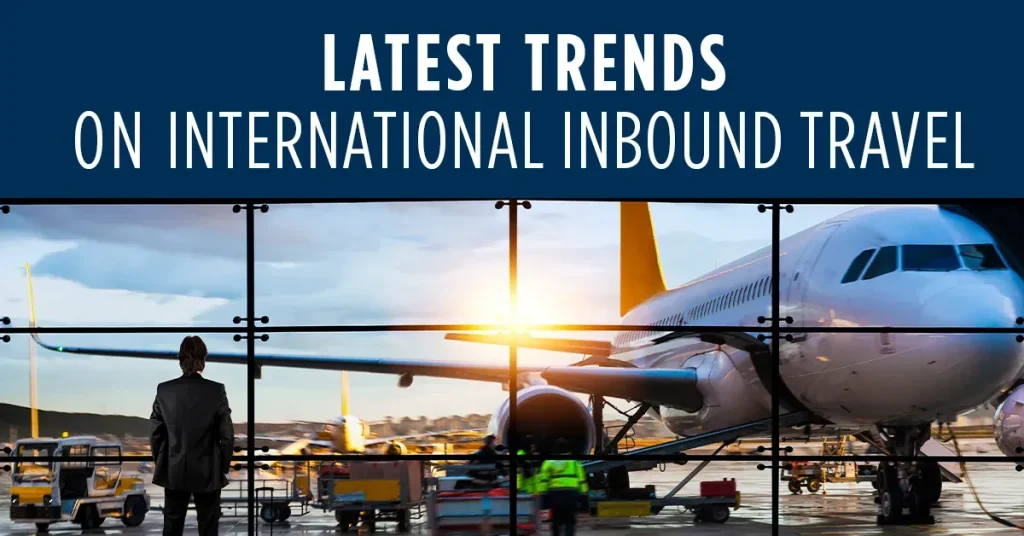International inbound travel has seen a complex mix of recovery in recent times, especially when looking at data from the U.S. Travel Association. While Canadian travel statistics reveal a significant decline of nearly 19% in visits during the first half of 2025, there’s a contrasting story from Mexico, where visitor numbers surged by 12.5%. This shift illustrates the dynamic nature of the travel industry recovery as it grapples with broader economic fluctuations. Notably, the drop in Canadian travelers has resulted in a stark loss of approximately $1.9 billion in travel spending, raising concerns among businesses reliant on international visitors. Despite these challenges, with projections for 2025 travel trends indicating increased international interest, there remains a glimmer of hope for the inbound travel sector to rebound effectively.
The landscape of overseas tourism in the U.S. reveals a tapestry of varied experiences as global trends shape visitors’ decisions. As international tourists navigate their travel choices, the dynamics of foreign visitor influx continue to evolve, particularly with shifts in travel patterns. Notable declines in arrivals from Canada contrast with the growing presence of visitors from Mexico, highlighting the fluidity of travel engagements. The repercussions on the tourism sector are significant, as stakeholders from various industries watch closely for signs of recovery. Emerging travel data suggests that while the intrinsic desire for exploration remains strong, external economic factors are influencing how travelers plan their trips.
The Current State of International Inbound Travel
International inbound travel to the U.S. is experiencing a complex phase of recovery. According to recent reports from the U.S. Travel Association, the overall numbers indicate a mixed bag, with some markets bouncing back while others struggle significantly. Notably, visitors from Canada have experienced a sharp decline of nearly 19%, a fall attributed to various economic factors and evolving travel preferences. This downturn has led to an overall dip in international visits to the U.S. by 3.4%, signaling a cautious approach among travelers looking to experience the vast cultural offerings of the country.
In contrast to the declines observed in Canadian tourism, there has been a noteworthy increase in visits from Mexican travelers. This demographic shift highlights the fluid nature of the international travel landscape, where fluctuating visitation patterns can stem from geopolitical events, economic stability, and marketing efforts directed at engaging visitors from neighboring countries. June alone marked a dramatic increase in incoming visitors from Mexico by 14.8%, showcasing resilience in the face of broader economic concerns affecting global travel.
U.S. Travel Statistics and Economic Impact
U.S. travel statistics for the first half of 2025 reveal stark contrasts between different countries of origin. The decline in Canadian travel can be partially attributed to economic uncertainties and shifting consumer preferences as more Canadians reevaluate their travel plans amidst financial pressures. This situation has resulted in significant economic ramifications, projecting a loss of $1.9 billion in travel spending—an alarming figure that speaks volumes about the interdependence of international travel and the broader economy.
While Canadian visitors are pulling back, Mexican travelers are stepping up, contributing nearly half a billion dollars through their increased patronage. This influx not only helps to alleviate some financial pressures on the travel industry but also demonstrates a potential pivot in marketing strategies aiming to capitalize on growing markets. The U.S. Travel Association emphasizes the importance of addressing these dynamic shifts in visitor demographics to ensure sustained growth within the travel sector, especially as industries and businesses prepare for evolving travel trends leading up to 2025.
Canadian Travel Decline and Its Consequences
The significant decline in Canadian travel to the U.S. poses critical challenges to the travel and tourism industry. With a staggering 26% drop in visitation in June alone, it reflects a broader trend that could have lasting impacts, particularly for businesses that heavily rely on Canadian tourists. Attractions, hotels, and local economies in tourist-favored places like Las Vegas are bracing for potential downturns in revenue as the absence of these international visitors strains traditional income streams.
Moreover, the implications extend beyond immediate revenue losses; a decline in Canadian travel also affects the overall perception of U.S. destinations. Conversations around experiences and reviews play a pivotal role in international travel planning, and if Canadian visitors are diminishing, it could discourage future travelers from other countries. As the travel industry focuses on recovery strategies, understanding these patterns becomes crucial to preventing a prolonged dip in international tourism.
Mexican Visitor Increase: A Silver Lining
In a time of turbulent travel trends, the increase in Mexican visitors emerges as a bright spot for U.S. tourism. With a reported 12.5% rise in the number of visitors from Mexico during the first half of 2025, this change not only bolsters foot traffic to various attractions but also stimulates economic support for hospitality businesses nationwide. The surge in tourism from Mexico indicates a strategic pivot where U.S. travel marketing could increasingly target neighboring countries to counteract declines from more traditional markets.
Furthermore, the rising number of Mexican visitors aligns with broader travel industry recovery efforts. As businesses adapt to cater to this demographic, they are also likely to enhance the overall visitor experience, attracting a diverse array of travelers from various cultural backgrounds. This could potentially offset losses from other markets and strengthen the resilience of the travel sector amid uncertain global conditions.
Future Travel Trends for 2025
As we look ahead to the travel landscape of 2025, emerging trends suggest greater diversification in traveler demographics and preferences. Insights from the U.S. Travel Association indicate that consumer behavior is shifting, with travelers more inclined to seek experiences that align with personal values and social responsibilities. This could potentially reshape how destinations are marketed and who they are marketed to, targeting groups that prioritize sustainable travel.
Additionally, given the current dynamics seen with Canadian and Mexican travelers, the future travel trends are likely to emphasize creating tailored experiences that resonate with specific audience needs. This could involve enhancing marketing strategies aimed at attracting potential visitors from different regions, thereby ensuring that travel remains a priority for a broader audience even amidst economic uncertainties affecting consumer decision-making.
The Role of Major Travel Companies
Major travel companies like Hilton and Wyndham are closely monitoring the shifts in international visitor trends as they prepare to report their earnings. With Canadian travel witnessing a significant decline while Mexican tourism flourishes, these companies are tasked with recalibrating their strategies to address the changing landscape. Analyzing traveler preferences across different demographics will be vital for these companies to sustain their market positions as they anticipate the potential fluctuations in travel demand.
Moreover, as these companies prepare for the upcoming World Cup and other major events, understanding the implications of current statistics will be crucial. With international inbound travel being subject to changes in visa policies and economic conditions, the agility of these corporations in responding to market demands will determine their success in attracting varied audiences to U.S. destinations.
Las Vegas: The Impact of Visitor Declines
Las Vegas, known for its vibrant tourism sector, is not immune to the declining trends in international visitors from both Canada and Mexico. The luxury casinos and hospitality ventures are experiencing a dip in patronage, which could profoundly impact revenue streams during peak travel seasons. Specifically, establishments like Caesars and MGM are weighing the risks posed by this downturn amid concerns of reduced spending from their Canadian visitor base.
To counteract the declines, Las Vegas may need to innovate by enhancing the tourism experience through improved marketing strategies, increasing engagement with Mexican travelers, and tailoring offerings to attract a diverse range of visitors. Addressing these challenges with proactive measures will be vital in preserving Las Vegas’s reputation as a premier tourist destination, ensuring that it remains appealing even in the face of adversity from fluctuating international travel patterns.
Government Policies Affecting International Travel
The landscape of international inbound travel to the U.S. is also influenced by governmental policies that affect marketing efforts and visa regulations. Recent cuts in funding related to travel marketing, as discussed in the context of the tax-and-spending law, pose significant challenges for destinations aiming to attract international travelers. This decrease in promotion funds can directly impact the visibility of U.S. attractions on a global scale, especially as competitor countries ramp up their initiatives to draw tourists.
Additionally, increasing visa fees could further complicate the situation, potentially discouraging travelers from visiting the U.S. As the travel industry prepares for pivotal events in 2025, businesses must remain vigilant and adapt their strategies to navigate the regulatory landscape effectively. By advocating for supportive travel policies, stakeholders can contribute to fostering an environment that encourages growth and sustainability in the international tourism sector.
Consumer Sentiment and Travel Priorities
Consumer sentiment plays a pivotal role in international inbound travel trends. As the U.S. Travel Association noted, while travel remains a priority for many consumers, broader economic concerns significantly influence their decision-making processes. Travelers are increasingly seeking value-oriented experiences that offer unique attractions without breaking the bank, prompting the industry to rethink its approach to providing compelling packages and deals.
Understanding consumer sentiment not only informs marketing strategies but also guides the development of travel products and services that resonate with contemporary travelers. By emphasizing safety, flexibility, and personalization, the travel industry can rebuild trust and encourage more travelers to explore the diverse opportunities available in the U.S. in the coming years.
Frequently Asked Questions
What are the current trends in international inbound travel to the U.S. in 2025?
In 2025, international inbound travel to the U.S. displays mixed recovery trends. While visitor numbers from Canada have drastically declined, there has been a notable increase in travelers from Mexico, contributing to a complex landscape for the travel industry.
Why has Canadian travel to the U.S. declined in the first half of 2025?
Canadian travel to the U.S. saw a nearly 19% decrease in visits during the first half of 2025, with June reporting a 26% drop. This decline is attributed to broader economic concerns affecting consumer travel decisions.
How has the increase in Mexican visitors impacted U.S. travel statistics?
The rise in Mexican visitors has significantly offset the decline in Canadian travelers. In June 2025, there was a 14.8% increase in visitors from Mexico, contributing to a total 12.5% rise in the first half of the year, resulting in almost half a billion dollars in travel spending.
What is the financial impact of the decline in Canadian travel on the U.S. travel industry?
The decline of nearly 19% in Canadian visitors has resulted in a loss of $1.9 billion in travel spending, highlighting the critical economic impact of reduced international inbound travel from Canada.
What challenges does the U.S. travel industry face in recovering from COVID-19?
Despite a resilient approach to recovery, the U.S. travel industry is challenged by significant declines in Canadian travel, potential cuts to tourism marketing funding, and increased visa fees that could complicate international inbound travel efforts.
What role do major travel companies play in the current travel landscape?
Major travel companies like Hilton and Wyndham are closely monitoring changes in travel patterns. Their upcoming earnings reports may reflect the impact of shifting visitor demographics on international inbound travel, especially concerning Canadian and Mexican tourists.
How might upcoming events like the World Cup affect international inbound travel to the U.S.?
The World Cup is projected to impact international inbound travel trends to the U.S., but concerns over reduced funding for destination marketing and increased visa fees may hinder preparation for this major event.
What insights did the U.S. Travel Association provide regarding travel priorities?
The U.S. Travel Association noted that while travel remains a priority, economic uncertainties are influencing consumer behavior. They emphasized the resilience of international visits to the U.S., despite the notable decrease in visitors from Canada.
| Key Point | Details |
|---|---|
| Canadian Travel Decline | Visitor numbers from Canada dropped by nearly 19% in the first half of 2025. |
| Impact on Total Visits | Overall international visits to the U.S. decreased by 3.4%, resulting in a $1.9 billion loss in travel spending. |
| June Statistics | Visitation from Canada fell by over 26% in June alone. |
| Increase from Mexico | Visitors from Mexico increased by 14.8% in June and 12.5% in the first half of the year. |
| Financial Contribution of Mexican Travelers | 940,000 visits from Mexico resulted in nearly half a billion dollars in travel spending. |
| Economic Concerns | Broader economic issues are affecting consumer willingness to travel, despite travel being a priority. |
| Future of Travel Companies | Major players in the industry, like Hilton and Wyndham, are set to report their earnings soon. |
| Impact on Las Vegas | Casinos in Las Vegas are also experiencing a decline in international visitors. |
| Legislative Impacts | Cuts in marketing funding and increased visa fees may complicate the travel landscape. |
Summary
International inbound travel is facing a mixed recovery as 2025 progresses. While there has been a noticeable downturn in visitors from Canada, the increase in travelers from Mexico provides a glimmer of hope. The travel and tourism industry must navigate through economic concerns and potential legislative challenges to foster a stronger recovery in international inbound travel.



